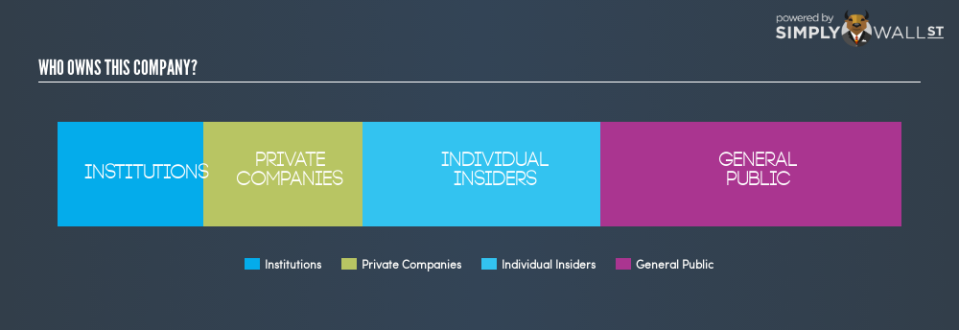Why Titagarh Wagons Limited’s (NSE:TWL) Investor Composition Impacts Your Returns

In this article, I will take a quick look at Titagarh Wagons Limited’s (NSE:TWL) recent ownership structure – an unconventional investing subject, but an important one. A company’s ownership structure is often linked to its share performance in both the long- and short-term. Since the same amount of capital coming from an activist institution and a passive mutual fund has different implications on corporate governance, it is a useful exercise to deconstruct TWL’s shareholder registry.
View our latest analysis for Titagarh Wagons
Institutional Ownership
With an institutional ownership of 17.44%, TWL can face volatile stock price movements if institutions execute block trades on the open market, more so, when there are relatively small amounts of shares available on the market to trade Although TWL has a high institutional ownership, such stock moves, in the short-term, are more commonly linked to a particular type of active institutional investors – hedge funds. For shareholders in TWL, sharp price movements may not be a major concern as active hedge funds hold a relatively small stake in the company. Although this doesn’t necessarily lead to high short-term volatility, we should dig deeper into TWL’s ownership structure to find how the remaining owner types can affect its investment profile.
Insider Ownership
Insiders form a group of important ownership types as they manage the company’s operations and decide the best use of capital. Insider ownership has been linked to better alignment between management and shareholders. 28.24% ownership of TWL insiders is large enough to make an impact on shareholder returns. In general, this level of insider ownership has negatively affected underperforming (consistently low PE ratio) companies and positively affected the companies that outperform (consistently high PE ratio). It may be interesting to take a look at what company insiders have been doing with their holdings lately. Insider buying may be a sign of upbeat future expectations, however, selling doesn’t necessarily mean the opposite as insiders may be motivated by their personal financial needs.
General Public Ownership
A big stake of 35.56% in TWL is held by the general public. This size of ownership gives retail investors collective power in deciding on major policy decisions such as executive compensation, appointment of directors and acquisitions of businesses.
Private Company Ownership
Another group of owners that a potential investor in TWL should consider are private companies, with a stake of 18.76%. While they invest more often due to strategic interests, an investment can also be driven by capital gains through share price appreciation. This kind of ownership, if predominantly strategic, can give these companies a significant power to affect TWL’s business strategy. Thus, potential investors should look into these business relations and check how it can impact long-term shareholder returns.
Next Steps:
TWL’s considerably high level of institutional ownership calls for further analysis into its margin of safety. This is to avoid getting trapped in a sustained sell-off that is often observed in stocks with this level of institutional participation. However, ownership structure should not be the only determining factor when you’re building an investment thesis for TWL. Rather, you should be examining fundamental factors such as Titagarh Wagons’s past track record and financial health. I urge you to complete your research by taking a look at the following:
Future Outlook: What are well-informed industry analysts predicting for TWL’s future growth? Take a look at our free research report of analyst consensus for TWL’s outlook.
Past Track Record: Has TWL been consistently performing well irrespective of the ups and downs in the market? Go into more detail in the past performance analysis and take a look at the free visual representations of TWL’s historicals for more clarity.
Other High-Performing Stocks: Are there other stocks that provide better prospects with proven track records? Explore our free list of these great stocks here.
NB: Figures in this article are calculated using data from the last twelve months, which refer to the 12-month period ending on the last date of the month the financial statement is dated. This may not be consistent with full year annual report figures.
To help readers see past the short term volatility of the financial market, we aim to bring you a long-term focused research analysis purely driven by fundamental data. Note that our analysis does not factor in the latest price-sensitive company announcements.
The author is an independent contributor and at the time of publication had no position in the stocks mentioned. For errors that warrant correction please contact the editor at editorial-team@simplywallst.com.

 Yahoo Finance
Yahoo Finance 
